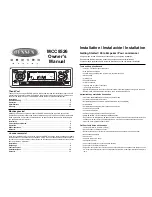
21-21
Section 21 Maintenance & Inspection
1
2
3
4
5
6
7
8
9
10
11
12
13
14
15
16
17
18
19
20
21
23
24
24
26
27
21.3 Maintenance on Each Unit
21.3.1 Radar antenna NKE-1125/A
、
1129
、
1130/A
、
1139
When turning off the power supply, do not hold down the power button of the
operation unit.
Otherwise, a trouble may occur due to termination failure.
Never directly touch the internal components of the radar antenna or indicator.
Direct contact with these high-voltage components may cause electric shock. For
maintenance, inspection, or adjustment of equipment components, consult with
our branch office, branch shop, sales office, or our distributor in your district.
Do not get close to the radiant section of the radar antenna. It is a rotating part,
and it may cause injuries if it suddenly starts rotating and consequently hits the
body. It is recommended that the radiant section be installed at a high place such
as on the roof of the wheelhouse, on the flying bride, on the trestle, or on the
radar mast so that no one can get close to it.
Keep away from the radar antenna during transmission.
Microwaves are generated from the front center of the radiant section of the radar
antenna at the levels indicated in the table below. Exposure to microwaves at
close range can result in injury (especially damage to eyes).
Microwave radiation level of the radar antenna
System 50
W/m
2
10
W/m
2
2.5
W/m
2
NKE-2103
n/a
26 cm
123 cm
NKE-1125/1125A/1129/2254 5 cm
81 cm
162 cm
NKE-1130/1130A/1139
11 cm
76 cm
181 cm
Make sure to install the radar antenna at a place higher than human height.
Direct exposure to electromagnetic wave at close range will have adverse effects
on the human body.
When it is necessary to get close to the radar antenna for maintenance or
inspection purposes, make sure to turn the power switch of the display unit to
"OFF" or "STBY".
Direct exposure to electromagnetic waves at close range will have adverse
effects on the human body.
When conducting maintenance work, make sure to turn off the power so that the
power supply to the equipment is completely cut off.
Some equipment components can carry electrical current even after the power
switch is turned off, and conducting maintenance work may result in electric
shock, equipment failure, or accidents.
















































